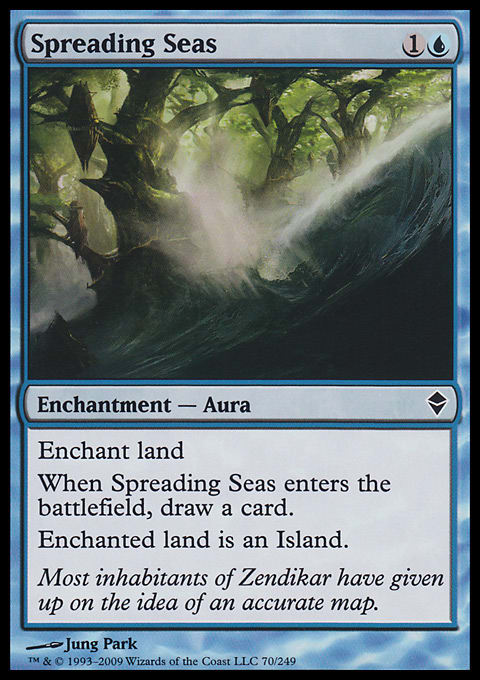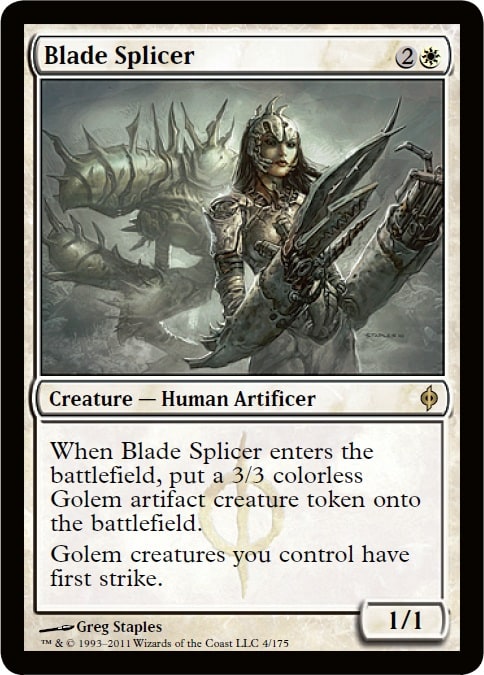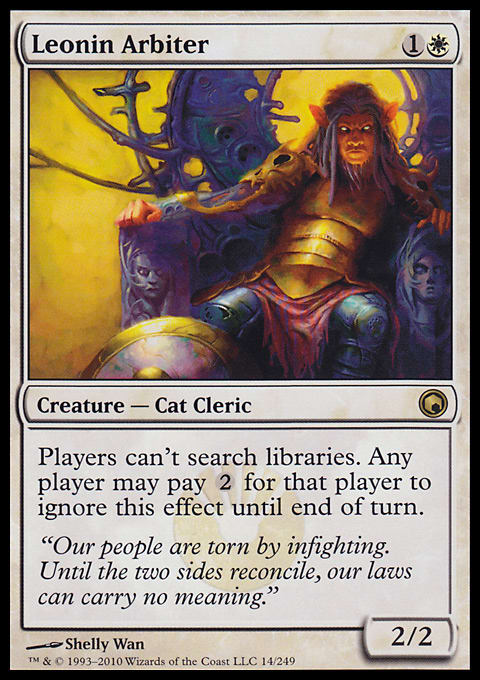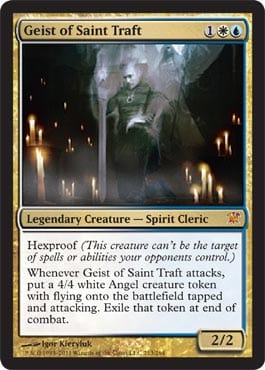Hey, gang!
I am now nose-deep in Modern testing, as Pro Tour Oath of the Gatewatch is in just a couple of weeks. Modern is going to be shaken up in the near future with the banning of Splinter Twin and Summer Bloom; I also have to account for a new set being released. These changes turn the format upside down, and I also need to find a new deck to play, as I was previously all-in on Grixis Twin.
I Top 8’d a 1K at BC Comix in Fenton a couple weeks ago with Grixis Twin and came across an interesting W/U Control deck piloted by RIW Hobbies grinder Raja Sulaiman in Round 1. The match was very close because Spreading Seas proved to be very strong in Modern.
His list went something like this:
W/U Control ? Modern | Raja Sulaiman
- Creatures (13)
- 1 Snapcaster Mage
- 3 Wall of Omens
- 4 Blade Splicer
- 4 Restoration Angel
- 1 Vendilion Clique
- Planeswalkers (2)
- 2 Gideon Jura
- Spells (19)
- 2 Negate
- 2 Spell Snare
- 3 Cryptic Command
- 3 Remand
- 4 Path to Exile
- 2 Detention Sphere
- 3 Spreading Seas
- Lands (26)
- 3 Island
- 3 Plains
- 1 Glacial Fortress
- 1 Moorland Haunt
- 1 Tectonic Edge
- 2 Mystic Gate
- 3 Hallowed Fountain
- 4 Celestial Colonnade
- 4 Flooded Strand
- 4 Ghost Quarter
I am biased to liking decks like this because my first Grand Prix top 8 was with W/U Tapout when Rise of the Eldrazi was the new set. It played very similarly to this deck, as my game plan was to run out Spreading Seas and Wall of Omens and follow it up with Gideon Jura and other big threats.
There are a number of great things going on in this list. Ghost Quarter and Spreading Seas form a great combo for a control deck because Tron and Eldrazi lands provide an angle of attack that is difficult to stop for traditional blue mages. The Urza’s lands stop counting for Tron assembly when you target them with Spreading Seas, and that can buy you much needed time. Many of the lands in Eldrazi decks are legendary, such as Eye of Ugin and Urborg, Tomb of Yawgmoth; when you Spreading Seas those lands, they will be sacrificed when they become replaced by another copy. An Urborg that becomes an Island is still called Urborg.
It seems that Spreading Seas isn’t good against every deck, but I have yet to sideboard out a single copy in any match. Affinity has creature lands that can overtake the late game. Burn has Boros Charm and Atarka's Command that make it very color-hungry. Jund and Junk have creature lands as well as Liliana of the Veil, which require multiple black mana. I wouldn’t overlook targeting a Ghost Quarter with Spreading Seas either (hopefully it’s tapped). Opposing Ghost Quarters can be annoying when your plan is to attack with Celestial Colonnade.
Wall of Omens is another underused card in Modern. It provides a buffer against Liliana of the Veil and can be a source of card advantage with Restoration Angel.
Gideon Jura overperformed for me in a local event. It was a great threat because I could tap out for it against Twin decks thanks to the +2 ability. I really like this Planeswalker against midrange, control, and aggro decks; it is weaker against combo because tapping out can be dangerous. Overall, I think this is an underrated card in Modern, and I rarely side it out. It’s important to have big spells in decks with so many cantrips (Spreading Seas and Wall of Omens) because cycling effects reduce your threat density. A cool trick is to animate the 6/6 and attack then blink it with Restoration Angel on main phase two so you can use the +2 ability.
Blade Splicer is fantastic against midrange strategies, as it provides a 1/1 body to sacrifice to Liliana. I am able to make the 1/1 body threatening because of Restoration Angel. It’s nice that Blade Splicer trades one-for-one with Kolaghan's Command, too. Etched Champion can be annoying for control and midrange decks, but the artifact creature created by Blade Splicer can block it.
Detention Sphere seems to be a very strange addition, and I was also skeptical at first. It’s a versatile removal spell that has Abrupt Decay as a major weakness. Sphere can answer Planeswalkers such as Liliana of the Veil and Karn Liberated, indestructible creatures such as Ulamog, the Infinite Gyre, and swarms of Spirit tokens from Lingering Souls. A majority of the strength of the card comes from its obscurity; opponents don’t play around it.
The counterspells are interesting in W/U Control because there are so many options to consider. Spell Snare is a staple in W/U decks because they are still live as the game goes long. It’s also valuable to have a counter on turn one on the draw if Spreading Seas is your second-turn play.
Remand has made the cut, and it really shines against opposing blue decks and Tron. Snapcaster Mage advantage is a real thing in blue mirrors, and this deck skimps on graveyard synergies, so having the Remand to counter a flashback spell is key.
A cool trick against Affinity is to Path to Exile a creature with Arcbound Ravager in play; once the opponent sacrifices it (because modular wouldn’t happen otherwise), you can Remand your Path to Exile to then use it on whatever creature is the target of the modular trigger. I generally feel that it’s a mini-game to create the biggest Remand blowout, as the possibilities are endless. The classic play is to Remand your own spell to save it from a counter, as it will get you a two-for-one. It’s also possible to counter uncounterable spells, and you will still draw a card. Remand becomes even better in this deck because you are taxing the opponent’s colored sources with Spreading Seas.
Mana Leak is nice, but I really hate the interaction with Path to Exile. You give the opponent lands by killing his or her creatures, so being able to counter spells with Mana Leak becomes difficult as the game drags on. Negate is a nice substitute because creatures are typically under control with this deck, so it shores up the rest of the field. I like to play Wall of Omens and Negate together, as doing so handles most of Modern’s threats.
The counter suite is rounded out with Cryptic Commands. I was skeptical of the Command at first because of all the colorless lands, but Mystic Gate can carry the weight of the Plains. Blade Splicer, Restoration Angel, and Celestial Colonnade are able to turn the corner quickly, which makes the Command be able to pivot from a counter to a spell that wins a race by tapping opposing creatures.
I talked to Raja about the bad matchups with W/U Control, and two of the decks he preferred not to play against are Splinter Twin and Amulet Bloom. Seeing as how this was the perfect set of changes to the banned-and-restricted list, I decided to innovate.
Here’s what I’m thinking about for Modern, accounting for the bannings as well as the release of Oath of the Gatewatch:
W/U Control ? Modern | Kyle Boggemes
- Creatures (15)
- 2 Wall of Omens
- 3 Leonin Arbiter
- 4 Blade Splicer
- 4 Restoration Angel
- 2 Vendilion Clique
- Planeswalkers (2)
- 2 Gideon Jura
- Spells (18)
- 1 Dispel
- 1 Negate
- 2 Cryptic Command
- 2 Remand
- 2 Spell Snare
- 4 Path to Exile
- 1 Oust
- 1 Detention Sphere
- 4 Spreading Seas
- Lands (25)
- 2 Plains
- 3 Island
- 1 Moorland Haunt
- 2 Hallowed Fountain
- 2 Mystic Gate
- 2 Seachrome Coast
- 4 Celestial Colonnade
- 4 Flooded Strand
- 4 Ghost Quarter
- 1 Eiganjo Castle
- Sideboard (15)
- 3 Stony Silence
- 2 Dispel
- 1 Negate
- 2 Geist of Saint Traft
- 2 Relic of Progenitus
- 1 Threads of Disloyalty
- 1 Condemn
- 1 Oust
- 2 Ethersworn Canonist
This deck is similar to the original list, except it takes a more proactive approach and I’ve reduced the average mana cost. I played against a Death and Taxes deck at a local Modern event, and my opponent played a Leonin Arbiter with three Plains in play. In two turns, I was able to use a Ghost Quarter, a Path to Exile, and two Spreading Seas to lock him out of casting white spells. I was very impressed at what my deck could do with an Arbiter in play, so I added them to the new version.
I reduced the number of counters in this deck to go along with the Fish strategy I’m now able to play. Arbiter, Spreading Seas, and Ghost Quarter are able to disrupt the opponent, but you are not able to lock him or her out of the game consistently. Since Leonin Arbiter is a 2/2 for 2 mana, I have more cards that make it seem that I’m flooding in the late game, so I went down to twenty-five lands; this is less of an issue when I play less reactive cards that make me want to leave up mana. I took this a step further by cutting a Negate for a Dispel; this is nice because I can play Arbiter on turn three and counter a Lightning Bolt or Kolaghan's Command.
Arbiter has a lot of synergies in this deck. You can use a Path to Exile to remove a creature from the game, and the opponent doesn’t gain a land unless he or she pays 2. The same is true with the four Ghost Quarters. It prevents the opponent from fetching lands unless he or she pays 2 mana for each Arbiter in play. This can be taken a step further with Restoration Angel; once the opponent pays 2 to ignore Leonin Arbiter, you can blink it, which requires an additional 2 mana to ignore the effect since it’s considered a new creature. You can potentially Time Walk an opponent by using Path to Exile or Ghost Quarter on his or her upkeep with Arbiter in play; he or she pays 2 mana to ignore the effect, but he or she is then faced with a decision to pay an additional 2 to gain the land when it is blinked.
I also want to play Leonin Arbiter because it stops searching effects such as Expedition Map and Eye of Ugin. Since Summer Bloom is banned, I think there will be more Tron and Eldrazi decks, and the Fish strategy will be good against them.
The real reason Leonin Arbiter is in the deck is that it brings balance. You can crush midrange strategies with Blade Splicer, Restoration Angel, Gideon, and Celestial Colonnade, but there are plenty of unfair matchups you have to face as well. It’s possible that tapping out for Blade Splicer could get you killed against Tron, Grishoalbrand, or any other wild brew, so I need to distract the opponent on turn two.
Oust is a forgotten spell that becomes more powerful as the need for instant-speed removal declines thanks to Splinter Twin being banned. Summer Bloom being banned also means you don’t have to worry about killing a Primeval Titan with haste. I want to have Oust in the early turns against creature decks because it doesn’t give the opponent a land. It’s also possible to put a Wall of Omens or Blade Splicer on top of your deck to gain 3 life.
Condemn is a cheap removal spell out of the sideboard I want against creature decks. I want cheap interaction post-’board so I don’t fall too far behind with Spreading Seas on turn two. A cool trick is to attack with a creature and then Condemn it at the end of combat phase. This ensures the opponent takes damage, but you also are able to gain life equal to the toughness, as a creature is still considered attacking at the end of combat.
I like the white removal spells in this deck because you need to be prepared for Thought-Knot Seer once Oath of the Gatewatch becomes legal for tournament play. Path to Exile, Oust, Gideon Jura, and Detention Sphere can take out the pesky 4/4. This is key because most decks won’t have many ways to kill things with more than 3 toughness, as Lightning Bolt is the flagship Modern removal spell. The same can be said about Reality Smasher if it becomes adopted in the new Eldrazi lists. It is worth noting that two Golem tokens from Blade Splicer can double-block down both of these creatures as well.
Geist of Saint Traft is a catch-all sideboard card for when you have too many cards you want to take out in a given matchup. Many decks aren’t prepared to fight hexproof creatures, and Restoration Angel can save it in combat once it has been blocked. You can continue the beatdown with Ethersworn Canonist against combo decks such as Living End and Storm. Relic of Progenitus is great against blue decks that play Tasigur, the Golden Fang, Snapcaster Mage, and Kolaghan's Command. The real reason it’s in the ’board is for graveyard-based combo decks such as Grishoalbrand and Life from the Loam strategies.
As you can see, Modern is going through some massive changes. There will be new archetypes that were long forgotten that will make a resurgence, so I want my control deck to have proactive elements. Splinter Twin was the previous balance for blue decks to be able to compete with unfair decks, and I believe Spreading Seas is the replacement. This deck has plenty of tricks, so you will be rewarded for your knowledge of the deck.
Thanks for reading! Now go out there and make everyone play some Islands!
-Kyle































